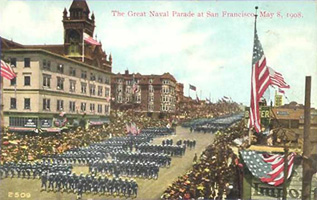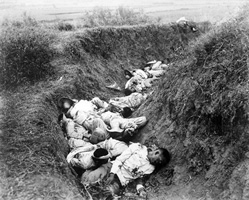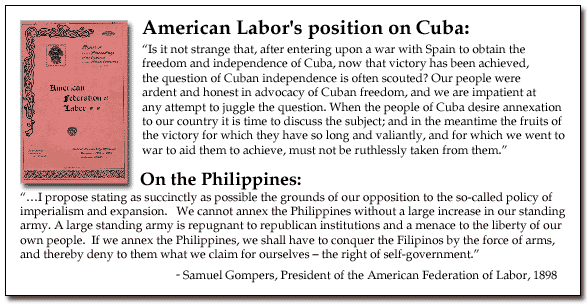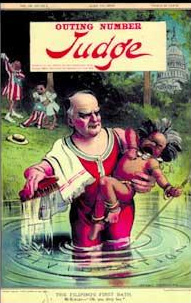1908-2008
Centennial of the Great White Fleet's departure from San Francisco Bay
and reflections on American imperialism
Lincoln Cushing, 4/1/2008
“History repeats itself, first as tragedy, second as farce.”
Karl Marx; Selected Works, vol. 2 (1942). Paraphrase of the opening sentences of The Eighteenth Brumaire of Louis Bonaparte (1852).
Between May 6 and July 7, 1908 San Francisco Bay was host to the most powerful naval fleet assembled to date. Sixteen new battleships of the Atlantic Fleet (later known as "The Great White Fleet" because they were painted white except for gilded scrollwork on their bows), accompanied by a "Torpedo Flotilla" of six destroyers and several auxiliary ships, had departed from
Hampton Roads, Virginia, on December 16,1907.
After leaving San Francisco the fleet visited Hawaii, New Zealand, Australia, the Philippine Islands, Japan, and Ceylon before arriving in Egypt on January 3, 1909.

"The Great Naval Parade at San Francisco, May 8, 1908" ; from the collection of Jack Daley
Between 1904 to 1907, American shipyards turned out eleven new battleships to replace the ailing fleet that won the Spanish-American War campaigns in the Caribbean (1898) and the early naval engagements in its Pacific extension, which became known as the Philippine-American War. Then-president Theodore "Teddy" Roosevelt had been assistant secretary of the Navy before serving in that war, and was dedicated to expressing American military power around the world. The naval tour was a bold bid to counter a growing Japanese presence in the Pacific.
This war, like many others, was a complex mixture of motivations and events. Despite popular rhetoric about the sinking of the Maine and mistreatment of the Cuban people by the Spanish colonial authorities, U.S. commercial and military interests fueled an invasion that subsumed the Cuban's and Puerto Rican's struggle for self-determination, resulting in geopolitical consequences that remain with us to this day. The situation in the Pacific was even worse. Although the Filipinos initially appreciated the U.S. role in evicting Spanish rule, tensions mounted as it became clear that our government's interest there had less to do with protecting democracy than it did with territorial expansion. Even before the Peace Treaty was signed, U.S. troops fired on a group of Filipinos and started the Philippine-American War, a vicious and ugly chapter in U.S. history that lasted until 1914.

Filipino casualties on the first day of Philippine-American War.
http://en.wikipedia.org/wiki/Philippine-American_War
This war had started out as a popular campaign, but as time went by the shine had worn off and some brave citizens began to raise their voices in protest. Among them was the great American author Mark Twain, who advocated the position that "An inglorious peace is better than a dishonorable war." Twain, along with many other prominent citizens such as Samuel Gompers of the American Federation of Labor and Jane Addams, first woman to win Nobel Peace Prize, were part of the Anti-Imperialist League that was formed to challenge this expansionist tragedy.

Openly racist views of the Filipinos underscored public debate and policy. Newspapers and magazines of the day used depictions of Filipinos as children and monkeys.
Whole villages were relocated into concentration camps, a method shamefully reminiscent of both the Spanish military practices we had earlier criticized in Cuba and the "strategic hamlets" we would later establish in Viet Nam. The actual death toll will never be known, but estimates of civilian deaths from famine, disease, and other war-related causes range from 200,000 to 600,000.

"The Filipino's First Bath" June 10, 1899; from The Forbidden Book, 2004
A hundred years later, these same issues resonate about our role in Iraq. Many of the issues are grotesquely similar - controversy over the use of "waterboarding" to extract information from prisoners (then it was called the "Water Cure"); massacres of Muslim civilians; racist depictions of the enemy. A January 2008 naval incident involving unidentified radio heckling of U.S. ships in the Gulf of Iran was eventually blamed on a "Filipino Monkey," a term with roots in the song "The monkeys have no tails in Zamboanga" written sometime between 1900 and 1906.
In 1981, San Francisco mayor Diane Feinstein instituted Fleet Week, a deliberate homage to the glory of Teddy Roosevelt's imperial force. At the time, the U.S. Navy had numerous facilities in the region, but with the collapse of the Soviet Union and the end of the Cold War, San Francisco's naval presence is virtually extinct. Yet the annual event persists, and has become an increasingly obscene expense of tax dollars. The Bay Area Peace Navy, among others, has called for its conversion to a broader and more inclusive celebration of the bay, like Seattle's annual Seafair.
2008 marks the centennial of this dark period in U.S. history. Let us use the opportunity to reflect on that legacy and try more peaceful and constructive approaches in our role as members of a global community.
Return to Docs Populi / Documents for the Public